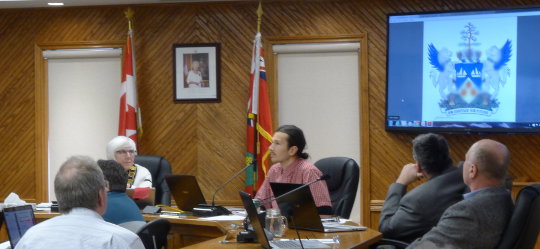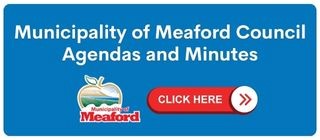Stephen Vance, Staff
The Municipality of Meaford will soon have a new coat of arms, after council gave unanimous approval to a final draft at their January 18 meeting.
The new coat of arms, which was prepared by Bruce Patterson, Deputy Chief Herald of Canada, attempts to bring together representative imagery relating to all areas of the municipality. It includes a shield divided into three sections with a blue background, and two white schooners representing ship building and recreational boating. Also included in the design for the coat of arms are images of apples, a wind-swept pine tree, two work horses, trillium flowers, and a wheat garb.
Councillor Tony Bell brought the idea for a new coat of arms to council shortly after the October 2014 municipal election, when he asked if the mayoral chain of office could be revised to include symbols that would represent all three of the former townships which were amalgamated in 2001. At their March 9, 2015 meeting, council approved a plan to create a Coat of Arms.
The Coat of Arms was prepared by the Canadian Heraldic Authority, which is headed by the Governor General. It will be exclusively used for ceremonial and protocol purposes. The Chain of Office, which is the official insignia of the Corporation of the Municipality of Meaford and worn by the mayor during council meetings, will be updated once the finished Coat of Arms has been received by the municipality.
Meaford’s 2015 budget included $6,000 for this project. The funds were carried over to 2016 to complete the project and to also undertake the creation of a new Chain of Office, which will also be supported through fundraising.
While the policy of the Canadian Heraldic Authority is that detailed images of the new Coat of Arms cannot be published until the final design is delivered to the municipality, the following is a full description of the armorial bearings included in Meaford’s new Coat of Arms:
Arms:
The shield is divided by an angled line pointing to the top centre. The top section is blue and on it are two schooners in white. The bottom section is white and on it are three apples native to the area of the Northern Spy, MacIntosh and Honey Crisp varieties.
The division of the shield alludes to the shape of the Municipality of Meaford (white) with Georgian Bay (blue) to its north. The schooners refer to shipbuilding and recreational boating.
The schooners represent east and west coming together under one municipality. The apples refer to the local apple growing industry, to the municipality’s emblem, and represent the past, present and future. They also refer to the three founders, the Township of St. Vincent, the Township of Sydenham, and the Town of Meaford.
Crest:
A green pine tree set on a base set with trillium flowers and staghorn sumac represented in their natural colours. This is set on a wreath of twisted cloth in white and blue, which may in turn be placed on a helmet draped in cloth mantling in blue lined with white.
The pine tree represents the municipality’s natural setting, and alludes to the trees painted by such artists as Tom Thomson and Fred Haines. The staghorn sumac represents local flora. The trillium flower indicates that the municipality is located in Ontario.
Supporters:
Two work horses, Percherons, coloured and dappled light grey with their tails and manes white, and with blue wings, their inner hind hooves each resting on a garb of wheat with a base of ferns. Around their necks are branches of maple in green.
The work horses, Percherons, evoke the agricultural identity of the municipality. Their wings allude to the crest and one of the supporters of the arms of the Earl of St. Vincent, namely Pegasus, a winged horse of Greek mythology. The municipality was named after Lord St. Vincent’s home in England, Meaford Hall, and the former Town of Meaford used his arms as its emblem. The garb of wheat is taken from the emblem of the Township of Sydenham, and the maple branches around the horses’ necks from that of the Township of St. Vincent. Fern is prevalent around trails and natural settings.










